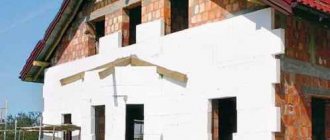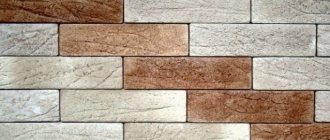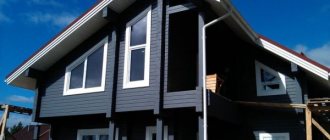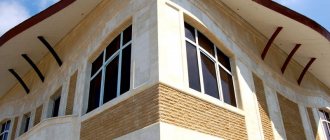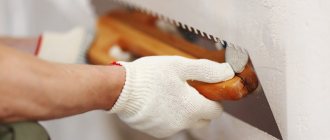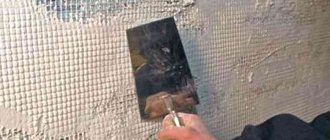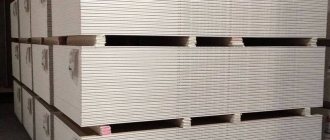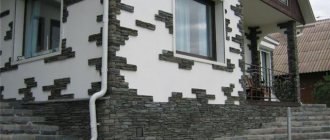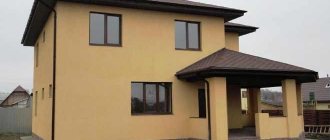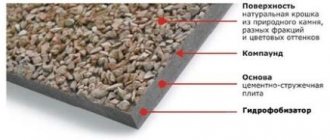Repair of brickwork seams
Seam cleaning
Using a plumber's chisel, cut out the mortar in the joint to a depth of about 16 mm.
To ensure good adhesion, clean the surface of the bricks at the joint. Thoroughly clean the joint with a brush to remove dust. Attention: be sure to carry out this work wearing safety glasses
Laying the mortar
Wet the seam with a brush and water or a hose with a spray gun. Place a 10 mm thick layer of mortar on the falcon (a wooden board with a handle to hold the mortar while working). Using the bottom plane of a cutting blade, which is smaller than a regular trowel, cut a thin piece of mortar and press it onto the seam. Since you are pressing the solution away from you, pick it up with the bottom plane of the cut. To fill long seams with mortar, you can use a flat surface jointer.
If you need to repair a large area, fill no more than two square meters with the solution at a time. meters of wall. Work from bottom to top and from left to right, being careful not to stain the bricks with mortar.
How to strengthen a brick wall - advice from experts
Construction of the façade of a private house made of brick.
Options and technology of cladding Reinforcement of a brick wall with metal overlays
If, after the building shrinks, cracks that are not too large form, they can be secured with metal bolts. To do this, they are placed inside and outside and strengthened. Strengthening the brickwork of walls: emphasis on the supporting part When it turns out that it is the supporting side that is damaged, it will be reinforced with masonry. Here you will need:
- directly existing support;
- material for new masonry;
- strip type steel;
- concrete and steel corners.
A certain order of work must be followed. It will be as follows:
- The supporting part will be reinforced with brickwork. Moreover, additional reinforcement will need to be done every four seams.
You can also reinforce it with steel corners. And then everything is lined with concrete. Sometimes the support is changed completely. For this purpose, all structures that transfer the load to it will be strengthened with a rack with braces. Only after this will it be possible to disassemble them. Subsequent laying of the new supporting part will be carried out again with reinforcement laying every three (maximum five) rows.
Repair and strengthening of brick walls
Repairing brickwork of external walls using jointing
If the reason for the deformation of the masonry is weathering of the seams to a great depth, then this worsens its thermal characteristics and also reduces the load-bearing capacity. Such a defect can be eliminated by strengthening the seams with cement mortar.
Before joining the walls, the seams are cleaned and thoroughly washed with water. Then they should be filled with cement composition and smoothed with a special tool.
Lintels with single cracks are restored by injecting a liquid composition (polymer cement or cement) into them.
When eliminating defects in arched lintels, the load is initially removed from them and then completely shifted.
Repair of ordinary and wedge lintels is created by strengthening the liner of reinforced concrete or steel beams.
Repairing cracks in brick walls
After the building has completed shrinkage, small flaws in the brickwork can be eliminated with concrete mortar, having prepared the wall in advance. If they are wide enough and in large quantities, then re-lining the damaged area is used.
Restoration of severely deformed areas of brickwork
The loss of the load-bearing capacity of some parts of the wall leads to the need to replace them with the entire thickness of the outer brick wall. This method allows you to completely restore the building to its original appearance and eliminate the defect as accurately as possible.
Progress:
- Initially, you should create a temporary fastening of the upper section of the wall that is not subject to replacement;
- then you need to disassemble the damaged area and re-arrange it. For this purpose, brick and mortar M100 is used;
- The masonry must be carried out with the bricks fully seated. The top between the old and new masonry is carefully sealed with a semi-rigid cement mortar M100;
- when laying the walls, which will then be included in the joint work, it is allowed to use wedging of the mixture using steel wedges;
- dismantling of the temporary fastening is done after reaching 50% of the design strength of the new masonry.
Recommendations:
- before starting work on relaying walls, it is necessary to eliminate the causes of deformation;
- load-bearing brick walls that do not need to change floors are re-laid with preliminary installation of multi-tiered temporary fastenings;
- temporarily created fastenings are removed a week after the completion of the last tier of masonry;
- Before unloading the required area from the wall above, unloading beams should be laid above it on both sides, punching and sealing their furrows. The planting of the latter begins from a weaker area. All this can be done using a pneumatic hammer. The vertical gaps between the masonry and the beam are filled with a plastic cement composition, and the gaps between the lower surface of the masonry and the top of the beam are treated with a hard and greasy cement solution.
Selection of materials for repairs
Facade painting technology
Repairing the facade not only increases the durability of the entire building and gives it a well-groomed appearance, but can also completely change the appearance of the house through the use of modern finishing materials. The most popular types of coatings are:
- different types of decorative plaster.
- wood, plastic, vinyl, metal siding.
- finishing tiles (fiber cement, ceramic, brick, artificial and natural stone, fiberglass).
- porcelain stoneware
Plaster mixtures are most often used when making the facade of a house with your own hands. Nowadays the following plasters are widely used: silicone, acrylic, with insulation, decorative. Thanks to plaster, the walls have a uniform coating, and its durability depends on the material of the main walls (concrete, brick, wood). The only drawback of this finishing method is the large amount of work and the duration of the repair.
Plaster facade is a common way to give a house a finished look
Often used in repairs are materials such as porcelain stoneware, various types of tiles, and finishing bricks. Such coatings are classics, although they are expensive materials. Tiles imitating wood, brick or stone have a very presentable appearance and are not difficult to care for, since most types have a dust-repellent coating. A wide range of colors, different sizes and shapes of tiles allow you to create a unique home exterior.
House facade after reconstruction with decorative stone
Finishing with siding panels is also the most common option when renovating a building. Most often you can find houses finished with fiber cement, aluminum or vinyl siding. Such panels not only protect the building from the influence of the external environment, but also provide good ventilation of the walls and act as insulation. In addition, siding is quickly installed; if the walls of the house are brick or wooden, then the siding is attached directly to the base itself.
External restoration of a building is a whole series of repair work that requires certain skills and practice. Minor finishing work during cosmetic repairs can be done independently, relying on your experience and advice from craftsmen. But if your house has been severely “damaged” due to mechanical influences, as a result of negative natural influences (snowfall, hail, partial flooding), or simply collapsed due to the age of construction, then it is better to use the services of craftsmen. In this case, you will be sure that in a year you will not have to correct your mistakes and “patch” the facade of the house again.
Types and technology of brickwork repair
Puttying cracks
Technology for creating a ventilated facade
The resulting defect can be puttied.
When cracks up to 5 mm in size appear on the wall, the resulting voids are sealed with a solution. Before this, preparatory work is carried out:
- cleaning the treated areas from dirt and dust;
- removal of fungi and old masonry mortar;
- polishing damaged areas;
- preparation of a special mixture.
To seal cracks, you will need a cement-sand mixture in a ratio of 1:3. Repairing cracks in brickwork is done using a special construction gun with a sharp tip. The tool is placed inside the voids, after which the solution is squeezed out and distributed evenly. If the mixture leaks out, it is recommended to use a special beam when pouring
When the cracks dry out, it is important to monitor their condition. If the destruction has not stopped, it is important to find out the reasons, then begin to eliminate them
Sealing seams
First, the seams are cleaned of old mortar. If there are disconnected areas on the old masonry, you need to knock out the pieces, this will be done with a hammer. Next, the seams are weathered. To prevent the brick from absorbing moisture from the new mortar, as well as to improve adhesion, damaged areas are well treated with a special liquid. Next, take a trowel and jointing, with their help a new seam is formed, which is filled with an adhesive mixture. Restoration and repair of seams will help protect the masonry from further destruction.
Priming before painting
Before painting, the finished wall must be primed.
Repairing a brick wall can damage the layer of facing paint, so when the restoration is completed, it will be necessary to repaint the walls, but first the surface is primed. To do this, the wall is carefully leveled, cleaned of dust, dirt and old pieces of mortar, then a primer is applied.
Waterproofing
A common cause of damaged walls made of red or facing bricks is water. To prevent further increase in cracks and deformation of the seams, waterproofing is carried out. The damp wall is thoroughly dried, after which the surface is treated with a special water-repellent liquid. According to the technology, waterproofing work is recommended to be carried out in warm and dry weather.
Possible damage to masonry
To repair brick walls, you need to know what types of damage occur and their causes:
| № | Type of damage | Cause |
| 1 | Potholes, cracks, chipped corners | Formed under mechanical stress. |
| 2 | Damage and peeling of paints, plaster, cladding elements | Occurs due to destruction or deformation of brickwork. |
| 3 | Buckling of bricks in external masonry | Occurs as a result of shifts due to freezing and sudden thawing of groundwater or rupture of vertical intermediate connections. |
| 4 | Rust stains inside or outside | Indicate processes of corrosion of reinforcement or embedded parts in the wall. These factors lead to loss of solidity of the structure. |
Repair of brick walls must be carried out in a timely manner, this will prevent further damage to the integrity of the wall.
We repair 5 types of brickwork damage
Good brickwork will last a very long time. But in order for it to maintain its excellent appearance and perform all the functions assigned to it, the masonry must be periodically repaired. Even through very small cracks, moisture can penetrate a wall or slab, and when it freezes or thaws, it will destroy the laid brickwork.
Moisture is the main, but not the only pest of masonry. Depending on the deformation and problems encountered, repair of brickwork can be carried out in several directions.
Sealing cracks
Be sure to clean any existing cracks from dirt and dust. Then fill the cracks with liquid cement mortar with finely sifted sand (in a ratio of 1:3). It must be poured inside using, for example, a syringe.
If the cracks are more than 5 mm, then to repair them it is necessary to install an anchor or beam. In other words, shift the surface of the wall to a depth of half a brick and a width of 1-2 bricks. Then fill the crack with cement mortar and install a beacon.
If cracks appear in this place again, then measures will have to be taken to establish and eliminate the causes of its formation.
Seam repair
- First you need to get rid of the old solution. Loose pieces of masonry are removed using a chisel and an entrenching hammer. You will need a brush to sweep away crumbs and dust from the seams.
- Next, you need to moisten the seams and the bricks themselves with a spray. This process is necessary to prevent the bricks from absorbing the new mortar. In addition, this treatment will provide good grip.
- At the next stage, a pointed trowel and jointing are used. They will give the same type of seam as the old one.
- All that remains is to fill the prepared seam with a new solution and remove the excess with a brush.
Priming before painting
If the brickwork was painted, then the surface was probably damaged as a result of repairs. To restore its former beauty, the repaired areas should be primed again.
As a rule, no primer is required when painting new masonry. But after artificial intervention, a primer is needed so that the paint lays evenly.
Waterproofing
Water most often causes the destruction of brick walls
Therefore, if you decide to put the masonry in order, then at the final stage pay increased attention to waterproofing so that new problems do not arise. A highly specialized cement-based material is suitable
At the same time, during the processing process the surface of the brick must be absolutely dry.
The brick is crumbling and destroying the wall, let's fix it!
To correct masonry defects caused by crumbling bricks, use plaster over a fine-mesh metal mesh.
- The place where the brick crumbles must be cleaned to a solid base.
- Then use bolts and dowels to strengthen the mesh.
- Next, thoroughly wet the surface of the wall and apply a sand-cement mortar of medium viscosity.
- For one part of cement, take three parts of coarse river sand. When the wall is dry, all that remains is to wipe down the surface.
Brick is a durable material for construction. This is confirmed by the many surviving castles that have survived more than one century. But, like any building material, brick needs constant care and repair as necessary.
Timely repairs will help preserve the structure for many years. The types of repairs depend on the specific problem areas. If a problem occurs repeatedly in the same place, you should definitely look for and eliminate the causes of the defects.
What causes masonry to collapse?
Often masonry is destroyed due to incorrect calculations of the foundation.
To prevent the destruction of a building, you need to know why its integrity may be compromised.
Reasons for the destruction of a brick wall:
- violation of construction technology and incorrect calculation of foundation loads;
- different densities of the soil under the building;
- absence of expansion (temperature) joints;
- close proximity to groundwater;
- shrinkage of the foundation, insufficient or excessive depth of its foundation;
- beam deformation
- under the influence of moisture.
If there is a large layer of snow on the roof, this significantly increases the load on the supporting structures, which can lead to their shrinkage and destruction. To extend the life of the building, you need to promptly clear snow, drainpipes and repair the roof.
Inspection, preparation, repair of damaged areas
When starting to repair the facade of a cottage or country house, the first thing you should do is carefully inspect the facade and assess the damage. There is a high probability that the coating was destroyed not only in those places where it is visually noticeable.
The easiest way to identify hidden damage in the plaster on a wall is to tap it with a rubber hammer. In places where such damage is present, the sound will be dull, indicating the presence of a cavity under the coating or its partial peeling.
Work on major or current repairs should begin with the careful removal of loose and loose plaster. You can leave only those fragments that have a strong adhesion to the wall and have obvious strength characteristics. The foundation must be strong. If you leave fragments of plaster that do not have adhesion to the wall surface, then the layer of the new facade may crack and simply fall off.
After removing fragments of the old facade, the base must be thoroughly cleaned of dust and dirt. A good solution would be to use a medium pressure washer for this purpose.
The plaster mixture is applied to the cleaned areas and completely smoothed with the main surface
After drying, all areas with removed coating are carefully treated with a suitable primer emulsion. For this, depending on the area of the surface to be treated, rollers or brushes can be used. For large areas, it is worth using a sprayer. The purpose of the emulsion is to reduce the absorbency of the base and improve adhesion. It is necessary to use a primer to ensure proper adhesion of the new layer of plaster to the remains of the old one and the base of the wall.
Next, the cavities are filled with a leveling solution according to the standard method using a spatula
Pay special attention to the elimination of all irregularities on the wall and the absence of transitions on its surface
After the initial setting of the mortar, depending on its type, weight and weather conditions, from 30 to 90 minutes, the filled space must be carefully rubbed and smoothed. After this, at least 24 hours must pass before the start of a new stage in the facade repair. Regardless of weather conditions, the façade wall must be protected with a film: either from possible moisture ingress or from drying out too quickly in the sun.
Before you begin restoration, assess the situation
What you will need: tape measure, small ruler, level, plumb line, feeler gauge.
Before starting work on the restoration of brickwork, it is necessary to assess its technical condition. The research can be divided into three stages.
Superficial inspection
Visual assessment allows you to detect:
destruction (looseness, spalling, chips, potholes) and/or lack of individual bricks,
Rust on the surface of the masonry is a sign of loss of structural integrity due to corrosion of steel embedded parts or reinforcement.
Measurements
To clarify the data obtained during a visual inspection and assess the extent of damage, it is necessary to measure:
- thickness and depth of cracks,
- seam thickness,
- angles of deviation of the masonry from the vertical and horizontal in the plane of the wall (at the seams),
- angles of deviation of the masonry from the plane of the wall.
Before restoring the brickwork, it is necessary to eliminate the root causes of deformation, otherwise repeated destruction cannot be avoided.
Monitoring the development of deformities
If cracks appear in the masonry, it is necessary to monitor the dynamics of destruction. To do this you need:
Composition analysis
If there is efflorescence on the masonry, it is also recommended to conduct a laboratory study of its chemical composition. It allows you to find out the amount of sulfates, nitrates, salts and moisture contained in the masonry.
Material for analysis is taken from four points distant from each other.
Cases when masonry is considered emergency
- Bricks or masonry blocks overhang and threaten to fall.
- The masonry is deviated from the vertical by more than 1/200 of the wall height or 1/3 of the masonry thickness.
- The masonry bulges (sticks out from the plane of the wall) by more than 1/200 of the height of the deformed area or 1/3 of the thickness of the masonry.
- Cracks cross four or more courses of masonry.
- The damage to the masonry is more than 2 cm deep.
- Disorder or separation of masonry rows is observed.
Types of repairs
The appearance of the facade of any building is very important for creating a harmonious impression of the architectural object
Therefore, the quality of repair work is very important. Basically, repair work to restore facades comes down to plastering work
Finishing facades with plaster has not only an aesthetic function: modern plaster compositions can protect a building from moisture and increase thermal insulation and fire retardant properties. Plaster protects the walls of a building from the adverse effects of atmospheric factors, and the strength and stability of the plaster layer can extend the life of the building.
There are two main types of repairs: partial and major.
Partial repair of the facade involves performing restoration work on individual sections of the wall. In this case, the correct selection of materials for repair in terms of compatibility plays a special role; for example, cement compositions can be repaired using similar cement-sand mortars. This way, further cracking can be avoided in the future.
Major repairs of the facade are necessary when the damage accounts for more than 30% of the entire surface of the wall. In this case, the old plaster layer is completely removed, the wall is cleaned and re-plastered.
Brick facade repair
Buildings made of brick practically do not need facade repair work, since brick has excellent strength and stability. In rare cases, due to design errors or violation of construction technology, the need to repair the facade of a brick building still arises. In such cases, large cracks are repaired and the façade is restored - the destroyed bricks are replaced with new ones. It is advisable to carry out diagnostics of brick facades - tapping - annually.
Repair of panel facade
The bulk of houses in our cities are panel houses, and they are the ones that most often need repairs and restoration of facades. In houses of this design, damage begins primarily in the interpanel seams, where moisture accumulates. As a result, damage is caused not only to the appearance of the building, but also to the interior - cracks, condensation, and mold spots appear on the walls. Such defects are eliminated by sealing the interpanel seams. But the panels themselves are also capable of destruction under the influence of atmospheric influences. Restoration work for panel facades consists of plastering over reinforcing mesh, restoration of cladding or mosaics. Currently, decorative facade plasters are widely used.
Repair of ventilated facades
Currently, ventilated facades are becoming widespread: buildings are faced with composite materials and porcelain tiles. Cladding gives the building not only a modern and attractive look, but also allows you to not only effectively insulate the building, but also protect it from external influences and extend its service life. Decorative panels are mounted on metal structures. In some cases, it may be necessary not only to replace or restore the cladding, but also to repair metal guides.
You can order all types of facade repairs by phone or using the feedback form on the website of the company TEPLOSHOV.PRO. You can get advice on the types of work you are interested in and the materials used. Qualified specialists of our company will inspect the facade and carry out the necessary repairs quickly and with maximum quality.
Technology for repairing a damaged brick wall inside
The technology for restoring the integrity of internal brick walls is practically no different from repairing external masonry. The simplest and most cost-effective repair option is the counter-drilling method. Its essence lies in the fact that holes are drilled in certain places of damaged walls, which are completely filled with cement mortar to restore the integrity of the masonry.
One of the most effective ways to repair brickwork is to dismantle it, then re-build the wall and replace damaged bricks. The only disadvantage of this method is the cost and complexity of its implementation.
Preparing the wall in the apartment
To restore the integrity of the masonry, you will need the following tools:
- Master OK.
- Trowel.
- Hard wire brush.
- Chisel.
- Hammer.
- Hammer.
- Joining.
- Level.
- Container for preparing mortar mixture.
After identifying and eliminating the cause of the destruction of the wall, restoration work can begin, which will be aimed at restoring integrity.
Repair begins with cleaning the damaged area from dirt and dust, removing old mortar and damaged bricks. This can be done using a hammer and chisel, or a hammer drill. At the same time, work with these tools so as not to damage the bricks.
How to repair a brick wall?
After completing the preparatory stage, we proceed directly to the repair using the methods described above. The following types of solutions are used for this:
- cement-sand;
- gypsum;
- limestone;
- acrylic.
After preparing the solution, a special additive is added to it, which will improve its properties. The repair area should be moistened generously with water. Apply the prepared mortar mixture so that it fills the defective areas. In case of significant damage to the walls, special supports are used that will not allow the solution to fall out.
Stages of work
The list of works for cosmetic and major repairs is slightly different, but in general the workflow looks like this:
- Determining the nature of damage to the building. Based on the degree of wear and tear, it is clear whether to involve specialists or do the repairs yourself. At the same stage, if necessary, the drainage systems and ebbs are repaired, the cornices are repaired and the walls are tapped with a hammer for voids and cracks.
- Preparing the façade surface for repairs. This stage includes:
- cleaning walls from old finishes, sealing cracks in bricks and gaps in seams, eliminating unevenness. This is done with a hammer, chisel, spatula, or ax;
- Old plaster or paint must be cleaned until all loose material is removed. If there are cracks in the main wall, use a cutter to increase their width to remove excess deposits, glue them with reinforced mesh and seal them either first with polyurethane foam, then with plaster, or with the plaster itself;
- surface leveling. All existing protrusions are removed with a spatula, ax or cutter. We plaster the cracks and depressions and level the wall at the same level. Then, when the walls are dry, you can wash off the untouched areas with water from a hose to remove all dirt and dust.
- The next step is to apply the primer. Primers need to be applied a lot, with a wide brush and into all the cracks and holes. It ensures good adhesion of the finishing material.
- Plaster the walls over the entire surface with the first layer. Drying and plastering with a second, finishing layer. At the same time, at this stage, the window slopes and corners are leveled.
- If a large part of the facade requires repairs, then use a reinforcing mesh, which is then plastered.
- For the finishing layer, you can use ceramic tile adhesive; it is specifically designed for outdoor work and can withstand high temperatures. You can apply decorative plaster to such a solution or just paint it.
- It is also advisable to prime the surface before painting. Then the paint will last longer and its consumption will be less.
- Painting the facade. This job may seem easy, but for everything to come out beautifully, you need to use the right tool and paint in stages. You need to choose the right combination and mix the colors correctly. You will have to paint the facade several times, because the first layer will be pale. Therefore, you need to calculate the amount of paint when mixing colors.
Repainting the walls a different color is one of the ways to quickly repair the facade and give the house a new look
That's it, theoretically the façade of the house has been repaired. But in practice, when finishing the facade, different types of materials, insulating and soundproofing panels are used, depending on this the number of repairs changes.
Restoration and restoration of the facade
Restoration of building facades
in goes according to a certain plan. The procedure begins with sanitation and cleaning of surfaces, and the first step is to remove old paint. Modern technology offers a variety of methods to perform this labor-intensive process. Thus, it is very popular to apply a special composition that destroys old paint, and in the future it can be easily removed mechanically.
Removing street pollution is an absolutely necessary step when carrying out work such as facade reconstruction
. Thorough cleaning of the walls guarantees good adhesion of subsequently applied repair and preservative materials. To perform this technological cycle, various chemical cleaners are used, which, after application and exposure for a certain time, are also thoroughly washed off with water under pressure. At the same time, the remains of cement mortar, lime deposits and efflorescence from the surface of the facade are also removed, and the next stage will be the destruction of fungus, moss, lichens, and mold. If necessary, specialists will perform mechanical cleaning of the surface followed by treating it with special chemical compounds.
After cleaning the surface, the craftsmen begin to strengthen the masonry. High-quality restoration of the facade
made of brick requires mandatory such work. After thoroughly cleaning the surface, a special stone hardener is applied to it.
Only after these preparatory works have been carried out can restoration measures begin, which include:
- filling voids, cracks and interpanel seams with a special suspension;
- removal of chips;
- puttying;
- restoration, if necessary, of destroyed façade elements (including architectural stucco decoration).
Often, the reconstruction of a facade also includes its additional insulation using the wet method, which significantly increases the thermal protection of the building; for this, special thermal insulation panels can be used, for example. And conservation of the facade is the final stage of the entire restoration procedure. The use of modern protective equipment can significantly reduce the impact of adverse natural factors on building facades.
carries out work on the restoration of the facades of any buildings in a manner clearly specified by technology.
Contact our specialists by phone for consultation and preliminary calculation of the cost of repair and restoration of the facade
Discount on all types of work!
Technology for eliminating defects in brick rows from the outside
The volume and complexity of restoration work depend solely on the nature of the damage. The following types of repairs are distinguished:
- Puttying cracks begins with cleaning the damaged area from dirt, dust, rusty and greasy stains, followed by treating it with a deep-penetrating construction primer. To eliminate damage, you will need a solution of a cement-sand mixture in a ratio of 1:3 (cement + sand), which fills the defect as much as possible.
- Restoring the integrity of the seams. Before performing this procedure, you should clean the spaces between the bricks as much as possible from the old mortar. After this, clean the repair area well with a brush and moisten it generously with water. Next we move on to the restoration of the seam.
- Brick destruction is one of the most difficult and serious restoration procedures, since in this case a complete replacement of the damaged elements will be required. The ideal repair option would be to completely dismantle the masonry and then build a new wall.
Methods for repairing brickwork
There are various ways to repair masonry. Over time, defects appear on the outer brick wall of the house, which look like small cracks up to 5 mm in size or seams between bricks that begin to crumble. All these troubles lead to weakening of the load-bearing walls of your home, deterioration of the thermal insulation of the walls, and if they are not eliminated in time, moisture will enter the weakened areas, which will further aggravate the situation.
The main reasons for the slow destruction of walls can be identified as follows:
- Initially incorrect brick laying. The brick bonding technology was poorly followed and the mortar was of insufficient quality.
- The foundation of the house was not made in compliance with the basic rules, which led to its shrinkage. In this case, cracks in the brickwork appear under the roof of the building.
- Excessive load on the walls of concrete ceilings, as a result of which cracks appear below, closer to the foundation.
Let's consider two cases:
- Restoration of brickwork joints.
- Repairing cracks in a brick wall.
Restoration of brickwork joints
Sealing joints with lime mortar
To stop the seams between the bricks from spilling out, first of all, with a metal brush, we remove all the rotten mortar, reaching its solid state. Then, using an ordinary sweeping brush, we remove all the dust that remains in the seams between the bricks.
Prepare a solution of slaked lime. When quicklime hardens, it will swell and try to crawl out without giving a binding effect. Add sand to lime in the following proportion: 1 part lime + 3 parts sand, mixing with water. It is better to take washed river sand, since gully sand contains particles of clay, which will give the seams a yellow color.
Before the process of filling with lime mortar, problem areas are moistened with water and, using jointing, the solution is pushed into the damaged areas. After the lime mortar has hardened, the seams are cleaned with sandpaper.
Repairing cracks in a brick wall
If cracks up to 5–8 mm in size appear in the brick wall of your house, you need to do the following. Clean the seams in places where the destruction spreads perpendicular to the cracks so that it is possible to insert reinforcing bars with a diameter of 6 - 8 mm into these places of the seams, and in some cases it can be thicker, depending on the width of the seam. Then the places where the reinforcement is laid are sealed with concrete mortar.
Metal screed around the perimeter of the wall
It happens that this method does not give positive results, then they resort to the method of repairing the brickwork, using a wall screed around the perimeter using metal profiles. In other words, depending on the size of the entire wall, using electric welding, a frame is constructed from a large metal corner ranging in size from 63 to 110 mm, which is adjacent to the corners of the house and is pulled together (welded) together in several places along the perimeter of the wall with a metal strip. In “several places” – this is at the top, in the middle and at the bottom. After the screed is installed, you need to repeat eliminating the cracks using reinforcement.
If the size of the cracks reaches more than 10 mm, experienced craftsmen recommend dismantling the old masonry in these places and laying out new ones.
Note: all work to eliminate defects must be carried out after the cracks reach their maximum size and stop growing.
Crack repair
To seal cracks with an opening of no more than 5 millimeters, cement mortar is used. Before carrying out repair work, the section of the wall with a crack is cleared of debris and moistened with water. To clean the surface, you can use a brush, a hand sander, or compressed air. In order for the brick to adhere well to the cement mortar, its edges are slightly knocked down with a hammer.
Cracks in a brick wall with a width of 5 to 10 millimeters can be repaired using the method described above, replacing the cement mortar for sealing cracks with a sand-cement mixture.
Brick cracks with an opening of 10 millimeters or more require special attention. Do-it-yourself brickwork repair can be done in the following ways:
- using polyurethane foam - vertical cracks can be restored using this method. The foam is blown into the gap, after hardening the material is cut to a depth of about two centimeters, the resulting gap is sealed with cement mortar;
- using metal anchors and cement mortar - metal anchors are installed in several places along the length of the crack; the anchors are fastened to the wall using dowels. Seal the crack with cement mortar;
- by replacing the damaged area with new masonry - the area of masonry that has become unusable is dismantled, moving from top to bottom. To seal the resulting opening, restoration bricks are used, which are laid according to the “brick castle” principle.
Relaying brickwork, removing weak areas
Often the repair measure is to replace the brick in the damaged area with a new one. Here the order of work will be as follows:
- The surface areas selected for replacement must be strengthened with metal bolts (you can additionally support them with racks).
- The replacement will take place in turn: first of all, the edge is attached, then the middle and intermediate ones.
- After completing the masonry work, these temporary fasteners must be dismantled and the holes created by them must be sealed. The resulting gap itself, which runs between the bottom of the beam and the new masonry, must be wedged with cement mortar in a semi-dry state.
Stages of deformation of brickwork
- Tension in the structure that does not entail damage to the masonry.
- The appearance of minor cracking in some bricks, so-called hairline cracking.
- Connection of several clefts with vertical seams. This contributes to the delamination of the masonry.
- Gradual deformation of the base of the wall.
Already at the first signs of such manifestations, it is important to understand the reasons and monitor the quality indicators of the laid brick. It is necessary to monitor the binding of external walls, the height of the seams, maintaining a horizontal base and filling these gaps with the composition
Repairing a damaged wall
Replacing bricks
Remove any mortar from around the damaged bricks and use a chisel to break up any damaged or cracked bricks. If the damaged section of the wall consists of several bricks, remove the top ones first, then the bottom ones.
Use a brush to remove any remaining mortar and broken bricks. Wet the damaged area of the wall, as well as the new bricks, with water and lay them in the same way as if you were laying a new wall. Apply the mortar to the side faces of the bricks and lay them on the mortar, not forgetting to make a groove in it. When the mortar has set, unstitch the seams using the same method as used in the remaining seams of the wall. Keep the solution wet for three to four days.
How to split a brick
Splitting across
When working with brick, you often need to break the brick into small pieces. Using a pencil and ruler, draw a split line around the brick. If necessary, apply a slant line (inset below), but remember that a slant line is more difficult to split the brick. Wear goggles to protect your eyes from debris. Place the brick on the sand layer with the part you want to use facing you. Place the blade of a wide chisel on the split line and hit it with a hammer. Gradually deepen the groove around the brick. Listen to the sound of impacts. When the brick starts to crack, the sound will become dull and you may end the job with a sharp blow. Chop off any rough edges with a trowel.
Splitting along
Draw a split line along all four sides of the brick, dividing it in half. Use the square end of a pick to score the surface of the brick along the line (don't forget to wear safety glasses). For very hard bricks, use a chisel as shown above. Then grab the brick firmly with one hand and hit it sharply with the flat end of the hammer near the center of the chipped line. (You may need to practice a little before you can gently break a brick in half with one blow.) Use a thin hammer blade to level the surface of the brick.
It is more difficult to split bricks lengthwise than crosswise. If you have a power tool, you can use an abrasive disc instead of a hammer and chisel to make a groove, and then split the brick with a sharp blow of a hammer and a wide chisel.
Large cracks in external walls
- If the crack has a significant width, then anchors or beams (metal bond) are often used to secure the masonry.
- Masonry seams that have crumbled are sealed with a clay mortar with the addition of brick chips.
- Repair of cracks on wooden partitions, the surface of which is plastered and located near the stove, is carried out by jointing or applying plaster over a broken metal mesh.
- Cracks between partitions and walls or ceilings are sealed with plaster, having previously filled a metal mesh (chain-link type) over the area to be repaired.
- If there is a deviation of the partition on load-bearing walls and ceilings, then repairs begin by marking the vertical position of the partition and filling slats for support. Then wedges are driven between the partitions, walls and ceiling, and the cracks are widened. After the wedges are loosened, the partition is moved to the deviation distance to the thrust rail. Then the partition is fixed to the wall.
- Repair of cracks and cracks formed between partitions, walls and ceilings is done with limestone mortar, with the addition of alabaster.
- Partitions made of wood, in which sound insulation is compromised, are reinforced with auxiliary racks made of timber, with further cladding made of boards and plaster on the sheathing.
- Often, in rooms with high humidity that have wooden partitions, cracks appear as they rot. In this case, the rotten part must be replaced with new antiseptic or brickwork, laying it in half, hanging down the upper part of the partition in advance.
Causes of destruction of the integrity of brickwork
To prevent the destruction of a structure, it is important to know what affects its integrity. Below are common reasons:
- The construction technology has been violated.
- Miscalculations were made during the design.
- Proximity of groundwater.
- Lack or absence of expansion joints.
- Heavy load on the supporting structures and foundation of the building.
- Subsidence of the foundation.
If you notice the appearance of cracks or deformation of the brickwork, the first thing to do is to find out the reason that is affecting the structure and eliminate it as quickly as possible.
To do this, install gypsum beacons in places of cracks and monitor the dynamics. If after a month they remain intact, you can determine the scope of work and begin repairing the walls. If you don’t understand the reasons and start making repairs, then the damage to the integrity of the masonry will continue, and your efforts will be in vain. As soon as the causes of the violation are established, repair work should begin, since the progression of cracks increases and interconnected cracks in the building lead to the collapse of the masonry. Repairs not carried out in a timely manner will further destroy the integrity of the building. The destruction of brickwork takes place in several stages, let's look at them.
Prices for facade work
| 1 | sq. m | 750 | |
| List of facade works: installation of scaffolding, cleaning the facade surface from dust and peeling paint, jointing and sealing cracks in the walls, puttying the walls, priming the walls, painting the facade twice with water-dispersion paint | |||
| 2 | sq. m | 950 | |
| List of facade works: installation of scaffolding, cleaning the facade surface from dust and peeling paint, partial repair of plaster walls and slopes (up to 20%), jointing and sealing cracks in the walls, puttying the walls, priming the walls, painting the facade twice with water-dispersion paint | |||
| 3 | sq. m | 1250 | |
| List of facade works: installation of scaffolding, cleaning the facade surface from dust and peeling paint, partial repair of plaster walls and slopes (up to 40%), jointing and sealing cracks in the walls, puttying the walls using a grid, priming the walls, painting the facade twice with water-dispersion paint | |||
| 4 | Major repairs of the plaster facade (with complete plastering) | sq. m | 1600 |
| List of facade works: installation of scaffolding, beating off old plaster, plastering walls and slopes with cement-lime mortar, puttying walls, priming walls, painting the facade twice with water-dispersion paint | |||
| 5 | sq. m | 1450 | |
| List of facade works: installation of scaffolding, fastening of plaster steel mesh, plastering of surfaces with cement-lime mortar, puttying of walls, priming of walls, painting of the facade twice with water-dispersion paint | |||
| 6 | sq. m | 1250 | |
| List of facade works: installation of scaffolding, preparation of wall surfaces, step-by-step priming of surfaces, fastening of slab insulation with glue and dowels, installation of an adhesive layer in two times with a reinforced fiberglass mesh, installation of architectural forms, application of colored decorative plaster, painting with acrylic paint in two layer, installation of flashings, sealing of junctions of openings and communications input | |||
| Facade insulation, price - when using polystyrene foam (thickness 50 mm) | sq. m | from 80 | |
| Facade insulation, price - when using façade mineral wool board (50 mm thick) | sq. m | from 260 | |
| 7 | sq. m | 1550 | |
| List of facade works: installation of scaffolding, installation of a galvanized steel frame, fastening of slab insulation with installation of windproof foam, installation of facade fiber cement boards | |||
| 8 | sq. m | 1600 | |
| List of facade works: installation of scaffolding, installation of an aluminum subsystem, fastening of slab insulation, installation of porcelain tiles | |||
| 9 | sq. m | 1520 | |
| List of facade works: installation of scaffolding, installation of an aluminum subsystem, fastening of slab insulation, production and installation of composite facade panels | |||
| 10 | sq. m | 1520 | |
| List of facade works: installation of scaffolding, installation of a steel frame, installation of profiled steel sheets | |||
| 11 | sq. m | 600 | |
| 12 | |||
| 12.1 | Sealing seams without opening | p.m. | 128 |
| 12.2 | Sealing of seams with opening, without replacement of insulation | p.m. | 153 |
| 12.3 | Sealing of seams with opening and replacement of insulation | p.m. | 214 |
| 13 | |||
| 13.1 | Increase in the total cost of installation and repair of complex (rich in architectural details) and rusticated facades | % | 5…30 |
| 13.2 | Installation of small coatings on facades with a sweep width of up to 300 mm made of galvanized steel | p.m. | 180 |
| 13.3 | Installation of parapets made of galvanized steel with a sweep width of up to 600 mm | p.m. | 270 |
| 13.4 | Installation of window sills made of galvanized steel | p.m. | 225 |
| 13.5 | Hangment of drain pipes made of galvanized steel of round section with a diameter of 100 mm | p.m. | 300 |
| 13.6 | Protective covering of window openings with polyethylene film | sq. m | 30 |
| 13.7 | Painting window fillings | sq. m | 180 |
| 13.8 | Installation of decorative elements made of polystyrene foam (cornices, rods, platbands, etc.) on dowels finished with reinforced adhesive composition | sq. m projection | 1500 |
Construction - facade work in Moscow and the Moscow region. Inexpensive, high quality, with a guarantee!
Replacing bricks in masonry
Removing one damaged brick
Remove the solution using a special crowbar if you can find one. If not, do it with a chisel. The crowbar is also good because it allows you to work with two hands, and this speeds up the work. Remove the required brick and clear the area of any remaining mortar.
Brick replacement
Choose a suitable brick or chip off a part of it. Wet the hole and apply a thick layer of solution. Place the brick on a falcon or mortar board, placing its edge 15 mm above the row in which the brick will be located. Hammer the brick into the socket and trim off any remaining mortar.
Repairing minor damage
Home coating and grouting
Old walls are often built with lime mortar, so this is what is used when restoring brick walls.
Other reasons to use lime mortar:
- high ductility.
- good adhesion to old masonry elements.
- slow hardening.
- no cracks during operation.
To restore seams and seal cracks in brickwork, restorers recommend MM-01 masonry lime mortar.
It is necessary to re-process all external joints to avoid differences in the color and structure of the old and new mortar.
Replacing individual bricks
At the preparation stage, old bricks were removed and the site was cleared of mortar residues and dust. It remains to install new bricks:
- lay the solution at the bottom of the niche in a layer of 10-12 mm;
- dip the brick in water;
- apply the solution to all faces except the bottom and front;
- install a brick in a niche;
- level the position of the brick using a mallet;
- remove excess mortar and rub the seams.
Aging brick
The new brick will look foreign in the old masonry.
Here are a few techniques to quickly age brick:
- processing with coarse sandpaper will make the surface less smooth;
- using a chisel you can add a few chips and chips;
- firing with a blowtorch “smudges” the surface - adds natural dark spots and stripes that do not contaminate hands and clothes when touched and are not washed off.
Recommended for use
Lime masonry mortar M50
Injection solution for strengthening masonry
Sealing cracks
After the reasons for the formation of cracks in the masonry have been eliminated and the deformation has stabilized, you can begin to repair the cracks. Cracks up to 10 mm are filled with a solution with a filler fraction of up to 1.25 mm, up to 5 mm with a fraction of no more than 0.1 mm.
Cracks with an opening of more than 10 mm require re-lining the wall or installing cross ties between the edges of the crack, followed by filling with mortar.
Features of renovation of residential buildings
Reconstruction of the facades of residential buildings allows you to improve performance characteristics, eliminate faults, and replace building elements. Reconstruction of an apartment building can be comprehensive or selective. A comprehensive reconstruction of a house involves the replacement of engineering equipment and structural elements of the building. In this case, work can be carried out both in the entire building and in its individual parts. Selective reconstruction involves partial replacement of structural elements.
In the process of repair work, only those building materials are used that ensure the proper level of functioning of all systems and structural elements.
